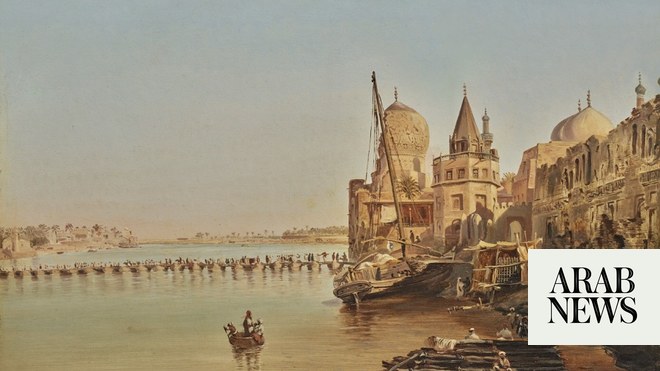
DUBAI: Sotheby’s Orientalist Sale, set to take place in London on April 25, consists of paintings representing “the landscapes, people and cultures of North Africa, Egypt, the Levant, Arabia and the Ottoman world during the nineteenth and early twentieth centuries,” according to the auction house. With online bidding opening on April 18, here are some highlights from the upcoming sale.
For the latest updates, follow us on Instagram @arabnews.lifestyle
‘An Encampment at the Port of Jeddah’
Alberto Pasini
Sotheby’s Orientalist Sale consists of paintings representing “the landscapes, people and cultures of North Africa, Egypt, the Levant, Arabia and the Ottoman world during the nineteenth and early twentieth centuries,” according to the auction house. This piece from the second half of the 19th century shows Jeddah’s port, which the Italian painter would have seen on his travels through Egypt, Saudi Arabia, South Yemen and the Gulf — a trip that marked the beginning of Pasini’s prodigious career as an Orientalist painter. Pasini’s interest in the East was first sparked by the French Romantic painter Théodore Chassériau, in whose studio Pasini worked for several months.
‘Al-Aqsa Mosque’
Carl Cowen Schirm
Schirm was a German painter fascinated by the Middle East. In 1880, he and two friends (and fellow painters) — Eugen Bracht and Adolf Meckel — set out on a journey that took them to Syria, the Caspian Sea and Mount Sinai. In this painting, Schirm is looking south from the Dome of the Rock in Jerusalem at the northern entrance of Al-Aqsa Mosque — one of Islam’s holiest sites. Schirm depicts the mosque’s “Cup” (its main ablution fountain) in the foreground of his painting.
‘An Arabian Stallion and his Groom, Egypt’
François-Gabriel Lépaulle
The prolific French painter travelled widely around North Africa and Turkey in the mid-19th century and is best known for his portraiture work. This painting, described by Sotheby’s as “a rare subject for the artist” shows a stallion and its groom in Egypt (Lépaulle has included the Pyramids in the background to avoid doubt over the location). “Tucked into the groom’s waist is an ivory-hilted Yataghan, whilst in his left hand he holds an Ottoman Kilij,” the auction notes state. “The presence of these fine items asserts his status as an important and powerful figure.”
‘The Old Boat Bridge, Baghdad’
Eugène Flandin
The famed French Orientalist is believed to have visited Baghdad in the 1840s, where he created a series of drawings which were later turned into engravings and included in his 1861 travel journal giving an account of his “Tour du Monde.” This work shows the Katah Bridge in Baghdad across the Tigris River. “To the right is the Tomb of Sheikh Omar, while in the foreground, on the river, can be seen a kuphar, a type of coracle or round rowing or paddling boat traditionally used on the Tigris and Euphrates in ancient and modern times,” the auction notes explain.
‘The Sheikh’
Otto Pilny
Pilny was a Swiss painter who focused heavily on Orientalist scenes. He visited Egypt twice — in 1889 and 1892 — creating works that “record not merely the landscapes and people that Pilny encountered, but the magical effects of Eastern light and sun,” Sotheby’s says. This particular portrait, painted in Cairo, shows an unidentified North African tribal leader who was likely a visiting dignitary. The notes state: “Armed with an early-19th-century Moroccan snaphaunce long-gun, and an Ottoman pistol whose butt is just visible above his belt, the sitter’s proud bearing and impeccable appearance speak of a man of power and authority.”
‘The Basket Weaver, Tangier’
Jean Discart
Discart’s extraordinarily detailed paintings made the Italian-born artist a prominent member of the Orientalist school in the late-19th and early-20th centuries. Here, Discart depicts a local artisan in the Moroccan coastal city of Tangier. His subject, the auction notes say, is “engaged in the intricacies of his trade. (Discart’s) decision to depict his subject in a moment of rapt concentration, conveyed by his furrowed brow and steadied hand, signals the man’s earnest devotion to his craft, perhaps not unlike Discart’s own.”
Discart was committed to presenting “the truthful and detailed representation of everyday life as he saw it” on his travels, hence the high level of detail here, from the weaver’s clothing and babouche slippers, to the copper pot and wooden door in the background.











